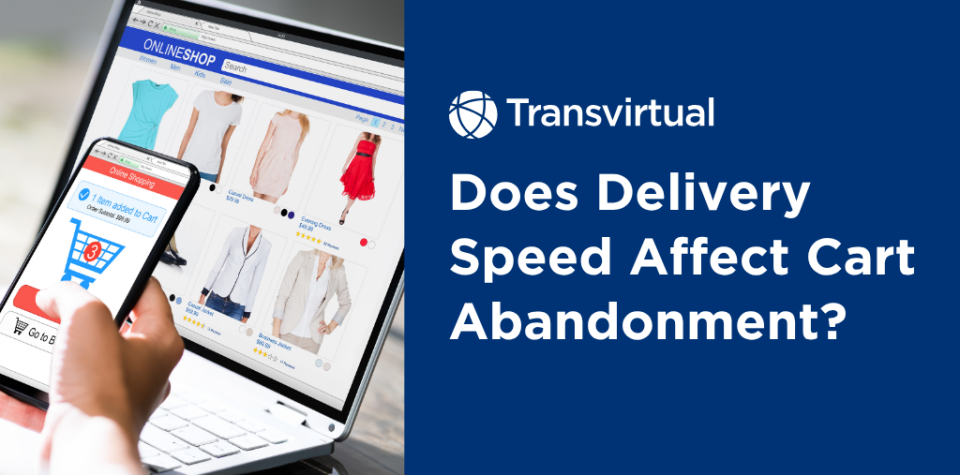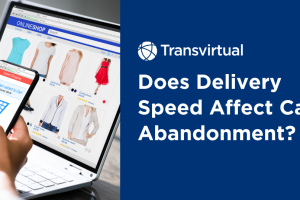Table of Contents
Every online store dreads the almost-sale. It’s the moment when the customer finds exactly what they want, heads toward checkout after adding it to their online shopping cart, then disappears forever. They neither made a purchase nor left an explanation. And all you have is an abandoned cart sitting in your backend dashboard like a reminder of revenue that might’ve been. The average cart abandonment rate for ecommerce stores is around 70%, making this a widespread issue that significantly impacts sales.
You can try everything – tweaking your UX, polishing product descriptions, improving website performance, even lowering prices. But the real reason why you see so much cart abandonment might be your delivery speed, or even your delivery ambiguity. Let’s explore it.
Why Shoppers Bail Before Checkout
Cart abandonment is a huge deal in the ecommerce universe. According to the Baymard Institute, just over 70 percent of online shopping carts are abandoned. That means 7 out of 10 potential sales evaporate just before the finish line.
There are plenty of culprits: unexpected costs, high shipping costs, complicated checkout process, clunky checkouts, lack of a guest checkout option, and forced account creation. These issues are major reasons why shoppers abandon their carts. But one of the biggest and least-discussed offenders is shipping speed.
23 percent of shoppers surveyed said slow delivery times made them abandon their order. Another 29 percent said vague or unclear delivery timelines were the last straw. And if shipping feels too expensive or slow and you can’t guarantee a delivery date, your would-be customers won’t hesitate to shop elsewhere. High shipping costs and a complicated checkout process are also key factors that make customers abandon their carts.
Same-day delivery options have definitely warped expectations, but consumer impatience isn’t the whole problem. It’s also about confidence. People want to know when their purchases will arrive. They might be ordering a birthday gift, a replacement charger, new shoes, whatever – and if your shipping options don’t meet their needs, they’ll leave.
“How Fast Can I Get It?” is a Major Question
Keep this stat in mind at all times as an ecommerce business owner: 75 percent of shoppers say they’re more likely to make a purchase when they see an estimated delivery date. They don’t want a range, a rough idea, or “2 to 5 business days.” They want a date.
That means that rather than giving a general shipping window, you need to provide specific, trackable delivery timelines as a conversion tactic. Displaying estimated delivery dates prominently on your product pages can increase customer confidence and drive more conversions.
Just think about the way the majority of people shop now. They’re scrolling, comparing options, and filtering by what’ll get to them fastest. If they see your competitor offers next-day delivery and you’re still offering standard shipping, you won’t even be considered.
Speed and Instant Gratification
It only feels like a few short years ago that we had to wait weeks to mail-order any product. Now, if a shopper can’t see the “Arrives Tomorrow” tag, there’s a good chance they’ll lose interest.
64 percent of millennials say they’re more likely to buy online if same-day delivery is an option. 88 percent of shoppers say they’re willing to pay extra if it means faster shipping. People just aren’t into the idea of “free but slow” anymore. They want fast and affordable, and the definition of “fast” keeps getting stricter.
Still, raw speed isn’t all that matters. Your customers want options. For example:
Some customers want ultra-low shipping costs as an option.
Some customers may need the item by tomorrow and are willing to pay to make it happen.
The rest are in the majority. They want a clear choice and a reasonable tradeoff.
Your objective shouldn’t be to make every product you sell ship within two hours. Instead, you want to show your buyers that you understand their urgency and provide them with options. That’s why you should offer tiered delivery options – standard, expedited, same-day, click-and-collect, etc. When used right, these can each be exceptional conversion levers.
Offering incentives like a small discount for choosing faster shipping or for orders above a free shipping threshold can encourage customers to spend more, increase your average order value, and reduce cart abandonment.
Some retailers have reported conversion increases of 10 percent or more after implementing faster delivery options. And when you delivery quickly, you’ll build trust. When you say specifically how quickly and your customer knows they can believe you, they’ll want to come back and spend more with your business.
How Logistics Partners Make (or Break) a Sale
The vast majority of shoppers aren’t thinking about logistics when they purchase something. They’re tapping the item they want on their screen, making the payment, and waiting for the parcel to arrive at their door. Behind that experience, though, is a web of warehouses, route optimisations, carrier networks, shipping cutoffs, and freight forwarders who coordinate international shipments to ensure goods reach their final destination. Logistics also involves managing the flow of raw materials and other factors that can impact delivery speed and reliability. All of this stays invisible to your customers (as it should) until it fails.
And when it does fail, you’d better believe they’ll take notice.
Logistics partners aren’t just another service provider like an insurance company. They’re more like a part of your sales team. If your fulfillment is slow, inconsistent, and frequently inaccurate, it’ll reflect directly on you. Your brand will be the one that takes the hit, your store will get the bad review, and your end customer won’t be coming back.
Fast, reliable shipping depends largely on your logistics partners. If you want to see repeat purchases jump by 9 percent, you want to be comfortable advertising two-day or faster delivery options. That’s the product of smooth operations guaranteed by a knowledgeable and highly competent logistics partner who can improve customer satisfaction by ensuring timely and accurate deliveries.
Smart logistics strategies to look out for include:
Zone-based warehousing to shorten delivery distances
Dynamic shipping rates at checkout based on actual locations
Transparent delivery timelines powered by backend logistics data
If you find a good partner, they’ll have no trouble handling these things. If you find a great one, they’ll integrate with your platform, allow you to offer multiple delivery speeds, and provide real-time tracking updates that your customers expect more and more these days.
Building Customer Trust Through Logistics
When it comes to ecommerce, customer trust is what drives repeat purchases and reduces cart abandonment.
While product quality and website design matter, it’s the logistics behind the scenes that often make or break the customer experience. When online shoppers add items to their online shopping carts, they’re not just buying a product—they’re buying into the promise that it will arrive on time, as expected, and with minimal hassle.
One of the most effective ways to build customer trust is by providing accurate estimated delivery dates and a variety of shipping options. Today’s customers expect transparency at every step, and 23% of cart abandonment cases are directly related to missing or unclear shipping information. If your ecommerce store can’t clearly communicate when and how an order will arrive, customers are far more likely to abandon their carts and look elsewhere.
This is where logistics companies and expert logistics partners come into play. By leveraging advanced supply chain management systems, online retailers can better manage inventory, respond to customer demand, and ensure that delivery speed matches customer expectations. Reliable logistics partners help you gain access to real-time data, allowing you to offer competitive shipping options—like free shipping thresholds or next day delivery—that attract more customers and reduce cart abandonment rates.
Don’t forget to optimise the checkout process
Beyond shipping, the checkout process itself is a critical touchpoint for building trust. Offering multiple payment options, including digital wallets like Apple Pay, reduces friction and reassures customers that their transactions are secure and convenient. A seamless checkout experience, combined with transparent delivery dates and multiple shipping options, can significantly improve conversion rates and reduce shopping cart abandonment.
Ultimately, investing in logistics expertise and technology is about more than just moving packages—it’s about meeting customer expectations, improving customer satisfaction, and building the kind of trust that turns first-time buyers into loyal advocates. In a crowded ecommerce landscape, businesses that prioritize logistics and customer satisfaction are the ones that will thrive, recover lost sales, and win more customers in the long run.
Turn Shipping Options into a Primary Conversion Strategy
Conversion rate optimization should be a primary focus when designing your shipping and checkout strategies. Your online store’s checkout page should never scare a customer away. Your delivery promises should always be accurate. And products should arrive long before a customer starts to wonder where it is.
This means that delivery options thanks to strong logistics should not be an afterthought. It’s more than the small dropdown menu on your checkout page. Analyzing cart abandonment data can provide valuable insights into why potential customers leave before completing a purchase, allowing you to refine your approach. Using retargeting ads is an effective way to recover sales from cart abandoners and potential customers who left without purchasing, by reminding them of the products they showed interest in.
Here are your main takeaways:
Speed is no longer optional. Two-day, next-day, even same-day delivery have become the baseline for many sellers.
Trust is based on transparency. Offer exact delivery dates, tracking info, and clearly communicated options to reduce friction and second-guessing before payment.
Shipping costs still matter. Yes, they’ll pay more for faster delivery, but costs should never feel arbitrary or out of step with product prices.
Offer multiple payment options. Providing a variety of payment methods at checkout can reduce cart abandonment and appeal to a broader audience.
Your logistics efforts should be part of your brand. Even if they’re not visible to your customers.
For example, a well-optimized Shopify store can implement these strategies—such as conversion rate optimization, retargeting ads for cart abandoners, and offering multiple payment options—to reduce cart abandonment and boost conversions.
You definitely want your customers to click “Add to Cart.” But the most important thing to your business is having them click “Place Order” and want to do it again. If you’d like to learn more about how you can get this done, schedule a free strategy session with a member of the Transvirtual team today.

